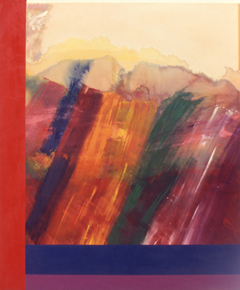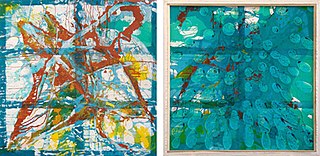Related Research Articles
Abstract expressionism in the United States emerged as a distinct art movement in the immediate aftermath of World War II and gained mainstream acceptance in the 1950s, a shift from the American social realism of the 1930s influenced by the Great Depression and Mexican muralists. The term was first applied to American art in 1946 by the art critic Robert Coates. Key figures in the New York School, which was the center of this movement, included such artists as Arshile Gorky, Jackson Pollock, Franz Kline, Mark Rothko, Norman Lewis, Willem de Kooning, Adolph Gottlieb, Clyfford Still, Robert Motherwell and Theodoros Stamos among others.

Abstract art uses visual language of shape, form, color and line to create a composition which may exist with a degree of independence from visual references in the world.

Helen Frankenthaler was an American abstract expressionist painter. She was a major contributor to the history of postwar American painting. Having exhibited her work for over six decades, she spanned several generations of abstract painters while continuing to produce vital and ever-changing new work. Frankenthaler began exhibiting her large-scale abstract expressionist paintings in contemporary museums and galleries in the early 1950s. She was included in the 1964 Post-Painterly Abstraction exhibition curated by Clement Greenberg that introduced a newer generation of abstract painting that came to be known as color field. Born in Manhattan, she was influenced by Greenberg, Hans Hofmann, and Jackson Pollock's paintings. Her work has been the subject of several retrospective exhibitions, including a 1989 retrospective at the Museum of Modern Art in New York City, and been exhibited worldwide since the 1950s. In 2001, she was awarded the National Medal of Arts.

Al Held was an American Abstract expressionist painter. He was particularly well known for his large scale Hard-edge paintings. As an artist, multiple stylistic changes occurred throughout his career, however, none of these occurred at the same time as any popular emerging style or acted against a particular art form. In the 1950s his style reflected the abstract expressionist tone and then transitioned to a geometric style in the 1960s. During the 1980s, there was a shift into painting that emphasized bright geometric space that's deepness reflected infinity. From 1963 to 1980 he was a professor of art at Yale University.

Raymond Saunders is an American artist known for his multimedia paintings which often have sociopolitical undertones, and which incorporate assemblage, drawing, collage and found text. Saunders is also recognized for his installation, sculpture, and curatorial work.

Ronnie Landfield is an American abstract painter. During his early career from the mid-1960s through the 1970s his paintings were associated with Lyrical Abstraction, and he was represented by the David Whitney Gallery and the André Emmerich Gallery.
Friedel Dzubas was a German-born American abstract painter.
Dan Christensen, was an American abstract painter He is best known for paintings that relate to Lyrical Abstraction, Color field painting, and Abstract expressionism.

Theodoros Stamos was a Greek-American painter. He is one of the youngest painters of the original group of abstract expressionist painters, which included Jackson Pollock, Willem de Kooning and Mark Rothko. His later years were negatively affected by his involvement with the Rothko case.

Paul Feeley was an artist and director of the Art Department at Bennington College during the 1950s and early 1960s.
Carol Lorraine Sutton is a multidisciplinary artist born in Norfolk, Virginia, USA and now living in Toronto, Ontario, Canada. She is a painter whose works on canvas and paper have been shown in 32 solo exhibits as well as being included in 94 group shows. Her work, which ranges from complete abstraction to the use of organic and architectural images, relates to the formalist ideas of Clement Greenberg and is noted for the use of color. Some of Sutton paintings have been related to ontology.
Neil Williams, was an American painter and educator. Williams was an abstract painter primarily known for his pioneering work with shaped canvases in the early 1960s. His paintings of the 1960s, 1970s and 1980s are associated with geometric abstraction, hard-edge painting, color field, and lyrical abstraction, although he did not readily subscribe to any category for his work. He taught fine arts at the School of Visual Arts, from the late 1970s until the early 1980s.
Stephen Westfall is an American painter, critic, and professor at Rutgers University and Bard College.

Nassos Daphnis was a Greek-born American abstract painter, sculptor and tree peony breeder.

Peter Plagens is an American artist, art critic, and novelist based in New York City. He is most widely known for his longstanding contributions to Artforum and Newsweek, and for what critics have called a remarkably consistent, five-decade-long body of abstract formalist painting. Plagens has written three books on art, Bruce Nauman: The True Artist (2014), Moonlight Blues: An Artist's Art Criticism (1986) and Sunshine Muse: Modern Art on the West Coast, 1945-70 (1974), and two novels, The Art Critic (2008) and Time for Robo (1999). He has been awarded major fellowships for both his painting and his writing. Plagens's work has been featured in surveys at the Museum of Modern Art, Los Angeles County Museum of Art (LACMA), Whitney Museum, and PS1, and in solo exhibitions at the Hirshhorn Museum and Las Vegas Art Museum. In 2004, the USC Fisher Gallery organized and held a 30-year traveling retrospective of his work. Critics have contrasted the purely visual dialogue his art creates—often generating more questions than answers—with the directness of his writing; they also contend that the visibility of his bylines as a critic has sometimes overshadowed his artmaking—unduly. Los Angeles Times critic David Pagel described Plagens's painting as a "fusion of high-flying refinement and everyday awkwardness" with an intellectual savvy, disdain for snobbery and ungainliness he likened to Willem de Kooning's work. Reviewing Plagens's 2018 exhibition, New York Times critic Roberta Smith called the show an "eye-teasing sandwich of contrasting formalist strategies," the hard-won result of a decade of focused experimentation.
André Emmerich was a German-born American gallerist who specialized in the color field school and pre-Columbian art while also taking on artists such as David Hockney and John D. Graham.

Thornton Willis is an American abstract painter. He has contributed to the New York School of painting since the late 1960s. Viewed as a member of the Third Generation of American Abstract Expressionists, his work is associated with Abstract Expressionism, Lyrical Abstraction, Process Art, Postminimalism, Bio-morphic Cubism and Color Field painting.

Dona Nelson is an American painter, best known for immersive, gestural, primarily abstract works employing unorthodox materials, processes and formats to disrupt conventional notions of painting and viewership. A 2014 New Yorker review observed, "Nelson gives notice that she will do anything, short of burning down her house to bully painting into freshly spluttering eloquence." Since 2002, long before it became a more common practice, Nelson has produced free-standing, double-sided paintings that create a more complex, conscious viewing experience. According to New York Times critic Roberta Smith, Nelson has dodged the burden of a "superficially consistent style," sustained by "an adventuresome emphasis on materials" and an athletic approach to process that builds on the work of Jackson Pollock. Writers in Art in America and Artforum credit her experimentation with influencing a younger generation of painters exploring unconventional techniques with renewed interest. Discussing one of Nelson's visceral, process-driven works, curator Klaus Kertess wrote, the paint-soaked "muslin is at once the tool, the medium, and the made."

Harriet Korman is an American abstract painter based in New York City, who first gained attention in the early 1970s. She is known for work that embraces improvisation and experimentation within a framework of self-imposed limitations that include simplicity of means, purity of color, and a strict rejection of allusion, illusion, naturalistic light and space, or other translations of reality. Writer John Yau describes Korman as "a pure abstract artist, one who doesn’t rely on a visual hook, cultural association, or anything that smacks of essentialization or the spiritual," a position he suggests few post-Warhol painters have taken. While Korman's work may suggest early twentieth-century abstraction, critics such as Roberta Smith locate its roots among a cohort of early-1970s women artists who sought to reinvent painting using strategies from Process Art, then most associated with sculpture, installation art and performance. Since the 1990s, critics and curators have championed this early work as unjustifiably neglected by a male-dominated 1970s art market and deserving of rediscovery.
Caroline Kent is an American visual artist based in Chicago, best known for her large scale abstract painting works that explore the interplay between language and translation. Inspired by her own personal experiences and her cultural heritage, Kent creates paintings that explore the power and limitations of communication. Her work, influenced by her Mexican heritage, delves into the potentials and confines of language and reconsiders the modernist canon of abstraction. She likens her composition process to choreography, revealing an interconnectedness between language, abstraction, and painting. Kent's artwork showcases an evolving dialogue of space, matter, and time, resulting in a confluence of drawings, paintings, sculpture, and performance, blurring the lines between these mediums.
References
- Cotter, Holland (May 12, 2000). "Stanley Boxer, 73, Prolific Artist Known for Abstract Paintings". The New York Times .
- Glueck, Grace. "Stanley R. Boxer". Stanleyrboxer.com. Quoted from The New York Times , April 23, 2004.
- Proctor, Roy (August 30, 2009). "A practitioner of art". Richmond Times-Dispatch.